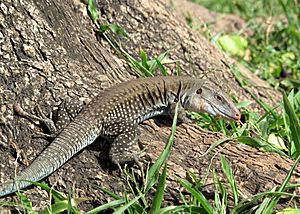Common Puerto Rican ameiva facts for kids
The Puerto Rican ground lizard (Pholidoscelis exsul), also known as the common Puerto Rican ameiva, is a type of lizard. It belongs to the whiptail family of lizards.
Quick facts for kids Common Puerto Rican ameiva |
|
|---|---|
 |
|
| Conservation status | |
| Scientific classification | |
| Genus: |
Pholidoscelis
|
| Species: |
exsul
|
| Synonyms | |
|
|
Contents
Where Do Puerto Rican Ground Lizards Live?
These lizards are found in many places around Puerto Rico. You can see them in coastal areas. They also live on nearby islands like the United States Virgin Islands, the British Virgin Islands, Isla Culebra, Isla Mona, and Isla Desecheo. You might even spot them in the Toro Negro State Forest.
Different Types of Ground Lizards
There are a few different kinds, or subspecies, of the Puerto Rican ground lizard. The main one is found in most places. However, the lizards on Isla Mona are a bit smaller. The ones on Desecheo Island are usually larger.
What Do Puerto Rican Ground Lizards Look Like?
The Puerto Rican ground lizard is a fairly large lizard. Male lizards can grow quite long, up to about 33 inches (85 cm) including their tail. The longest male body recorded was about 8 inches (20 cm). Females are smaller, with the longest body recorded at about 4 inches (9.9 cm).
Colors and Patterns
Their colors can be very different from one lizard to another. They are often gray, black, or brown. Many have white dots on their backs. Some have stripes along their sides, which can be different lengths and colors. Their bellies are usually white or blue-white with a mottled (spotty) pattern. The area under their chin is often light pink. Young lizards, called juveniles, have a bright blue tail. This blue color fades as they get older.
How Do Puerto Rican Ground Lizards Live?
These lizards like places with open spaces and loose, sandy soil. They prefer areas where the temperature stays above 75 °F (24 °C) all year. They usually live at elevations from sea level up to about 490 feet (150 meters).
What Do They Eat?
Puerto Rican ground lizards look for food on the ground. They mostly eat insects and small fruits. They also scavenge for dead animals or even food scraps in towns.
How Do Puerto Rican Ground Lizards Reproduce?
Female lizards that are old enough to have babies lay eggs. They usually lay 2 to 7 pink eggs. They bury these eggs about 4 inches (10 cm) deep in loose soil. This usually happens between June and August.
Life Span
As mentioned, young lizards have a bright blue tail. This helps them blend in or perhaps warns predators. They lose this blue color as they grow up. These lizards can live for more than six years.
What Threats Do They Face?
The main danger to Puerto Rican ground lizards comes from other animals that hunt them.
Predators
Some animals that eat these lizards include:
- Mammals: Feral cats, dogs, and mongooses.
- Birds: American kestrels, Greater Antillean grackles, and pearly-eyed thrashers.



